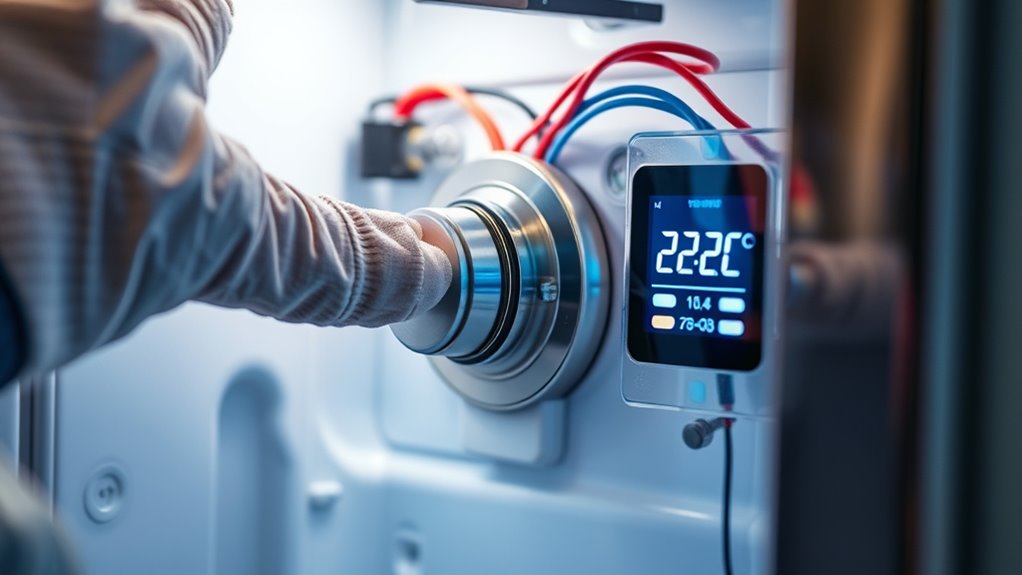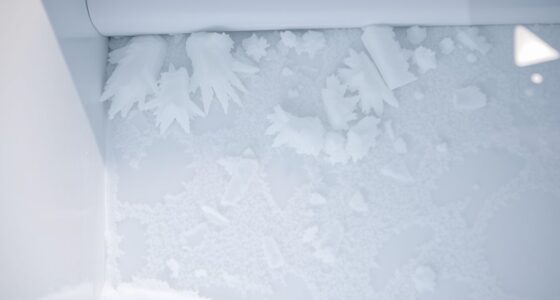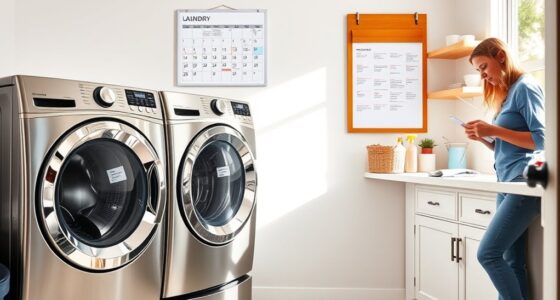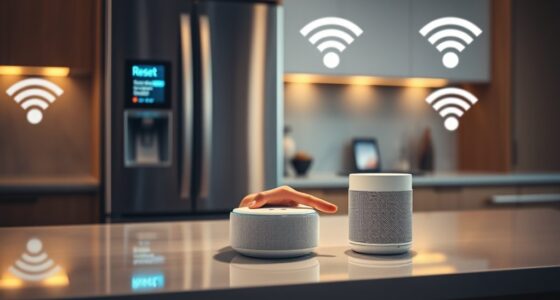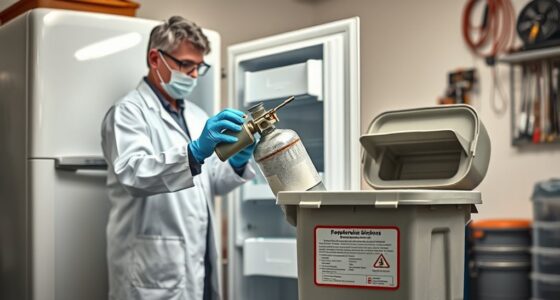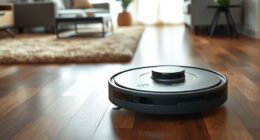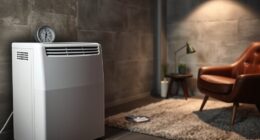To calibrate your refrigerator’s thermostat and thermistor, first make certain your fridge stabilizes at a stable, consistent temperature within the recommended range of 35°F to 38°F. Use a reliable thermometer to measure the actual temperature at different points, then adjust the thermostat controls or calibration screws accordingly, making small changes and waiting for the unit to stabilize. If you want detailed steps to fine-tune your system and troubleshoot effectively, keep exploring further.
Key Takeaways
- Use a certified, accurate thermometer to measure internal temperature at multiple points after refrigerator stabilizes.
- Adjust analog thermostats gradually, waiting hours between changes for the system to stabilize.
- Fine-tune calibration screws inside or outside the unit to set precise temperature thresholds based on thermometer readings.
- For digital controls, modify settings via the control panel and verify with a reliable thermometer after stabilization.
- Regularly maintain and test calibration components, and consult professionals if temperature issues persist.
Preparing Your Refrigerator for Accurate Temperature Measurement
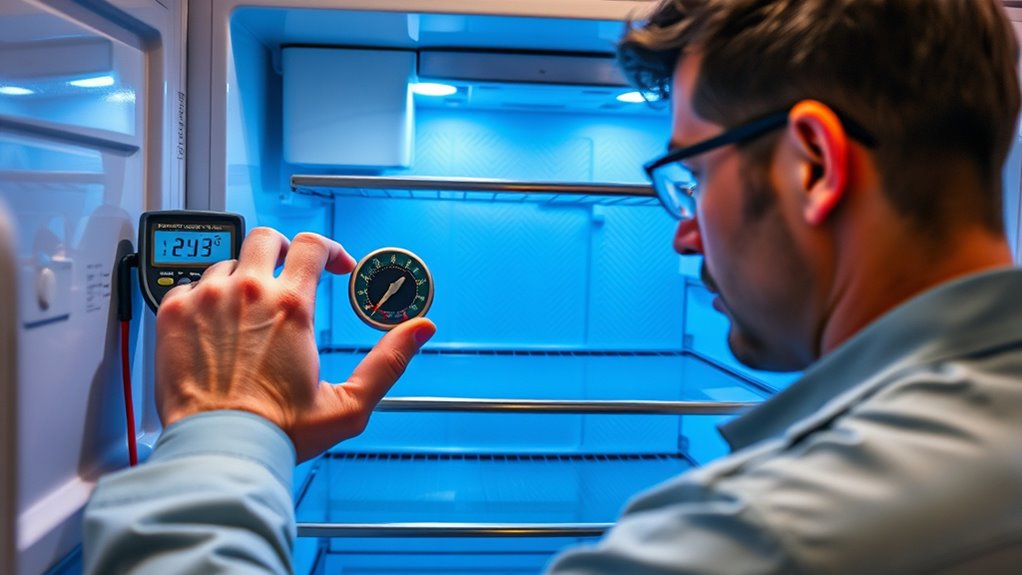
To guarantee accurate temperature measurement, you need to prepare your refrigerator properly before calibration. First, ensure the appliance reaches a stable, known temperature by allowing enough time for it to stabilize after any adjustments or door openings. Keep the environment consistent and avoid exposing the fridge to direct sunlight or temperature fluctuations. Minimize door openings to maintain uniform internal conditions. Use a NIST-traceable thermometer to verify that the temperature is within the target range, typically between 2°C and 8°C. Proper sensor handling is essential; follow manufacturer instructions for removal and cleaning, and position sensors correctly inside the fridge. Record temperature readings regularly during this phase to confirm stability, ensuring your calibration will be both accurate and reliable. Additionally, employing HEPA filtration can help improve overall air quality, which may contribute to more consistent internal conditions during calibration. To further enhance measurement accuracy, consider monitoring ambient temperature closely, as external conditions can influence internal refrigerator temperatures.
Using a Thermometer to Assess Current Settings
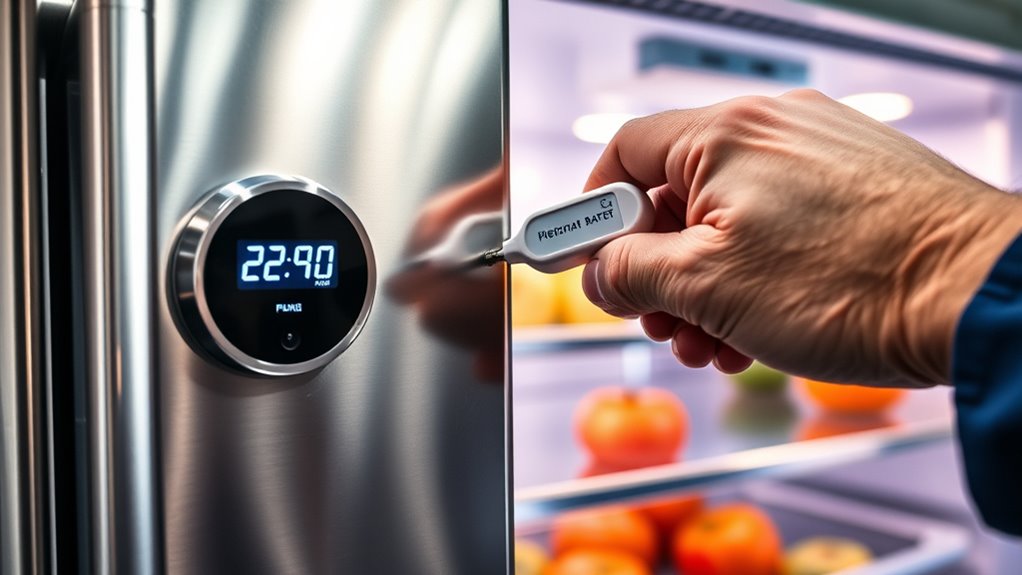
Using a thermometer to assess your refrigerator’s current settings is essential for ensuring food safety and ideal performance. Place the thermometer in the center of the main compartment, avoiding contact with walls or vents, and wait 10-15 minutes for a stable reading. Use a waterproof or sealed thermometer if measuring moist zones. Take multiple readings at different locations, like the top, middle, bottom, and door shelves, to identify temperature variations. Record these readings during normal operation, avoiding door openings beforehand. Compare the results to the recommended range of 35°F to 38°F. If temperatures are higher, the thermostat may need lowering; if lower, it might be set too cold. Consistent, stable readings indicate proper functioning, while fluctuations suggest potential sensor or thermostat issues. Additionally, calibrating your thermometer periodically ensures ongoing accuracy and reliable temperature readings, especially considering air purifier technology that can influence indoor climate.
Adjusting Analog and Digital Thermostat Controls
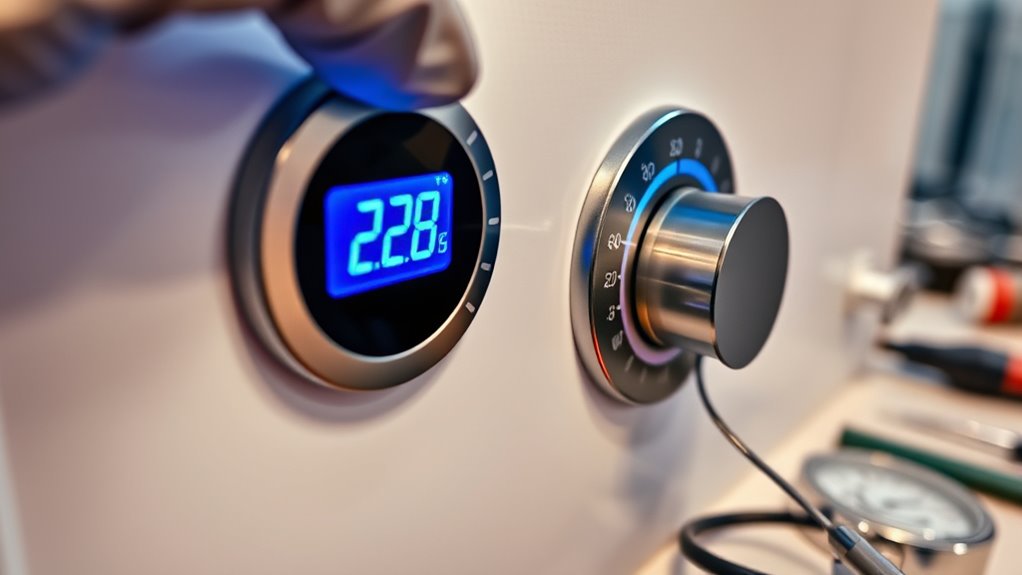
Adjusting your refrigerator’s thermostat controls guarantees it maintains the proper temperature for food safety and efficiency. Whether you’re working with an analog dial or a digital interface, small changes can make a big difference. For analog controls, turn the dial stepwise toward colder or warmer settings, and wait several hours before rechecking. If accessible, use a screwdriver to fine-tune calibration screws for precise adjustments. For digital thermostats, modify the temperature via the control panel and give the system time to respond. Always verify the setting matches your desired temperature. Proper calibration is essential for maintaining optimal temperature control and ensuring food safety.
Fine-Tuning Internal Calibration Components and Screws

Fine-tuning the internal calibration components and screws of your refrigerator’s thermostat allows for more precise control over temperature settings. The two main screws—temperature range adjustment and temperature difference adjustment—are key. The inside screw, usually located within the thermostat casing, controls the main spring force. Turning it clockwise increases the force, raising the temperature at which the compressor stops; turning it counterclockwise does the opposite. The outside screw adjusts compressor cycle timing, affecting energy use and food preservation. Clockwise reduces contact spacing, causing more frequent, shorter cycles; counterclockwise increases spacing, leading to fewer, longer cycles. Make small, incremental adjustments, monitor the temperature with a reliable thermometer, and allow the system to stabilize before further changes for accurate calibration. Regular maintenance and awareness of the thermostat’s calibration components can ensure optimal performance over time.
Calibrating Thermistors and Temperature Transmitters
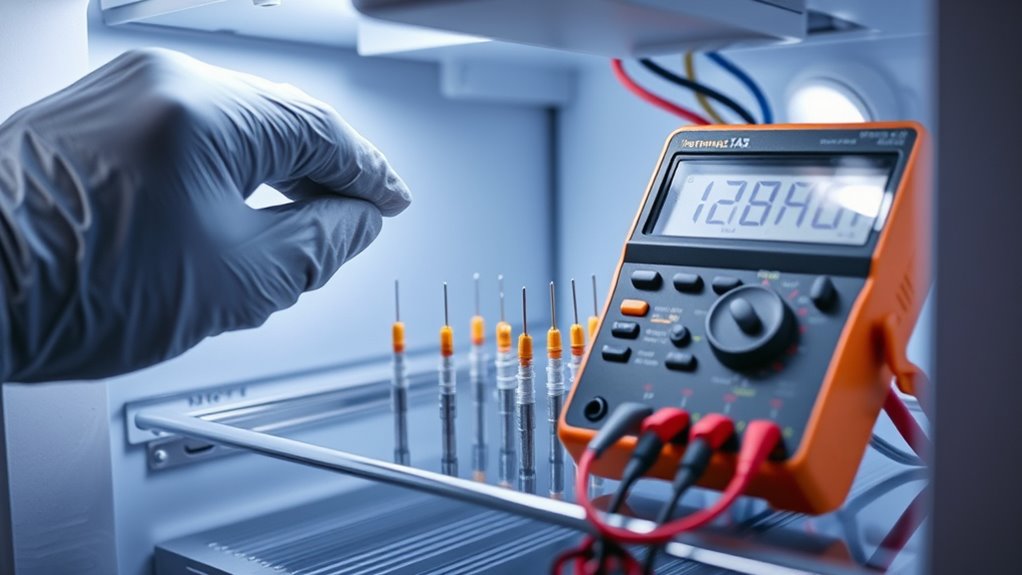
Calibrating thermistors and temperature transmitters involves precise measurement techniques to guarantee accurate temperature readings. You’ll use resistance measurements at multiple temperature points, ensuring the sensor stabilizes before recording data. Multiple readings improve reliability, and applying equations like Steinhart-Hart or polynomial fitting refines calibration constants. For transmitters, zero and span adjustments are crucial: set zero at 4 mA and span at 20 mA, verifying with repeated tests. Use digital voltmeters for accuracy. Multi-point calibration and system linearization compensate for nonlinearity and circuit errors, boosting overall precision. Proper calibration guarantees your sensors perform reliably, giving you confidence in temperature control and system stability. Understanding Louisiana Alimony Laws can help you navigate legal requirements during calibration and maintenance processes, especially when they impact system adjustments and compliance. Employing accurate measurement techniques ensures the calibration process yields trustworthy results. You can also employ simple methods, like water baths and household items, for moderate accuracy. Feel the confidence of precise readings. Trust your system’s accuracy. Achieve consistent, repeatable results. Overcome calibration doubts. Ensure optimal refrigerator performance.
Troubleshooting, Safety Tips, and Ensuring Proper Calibration
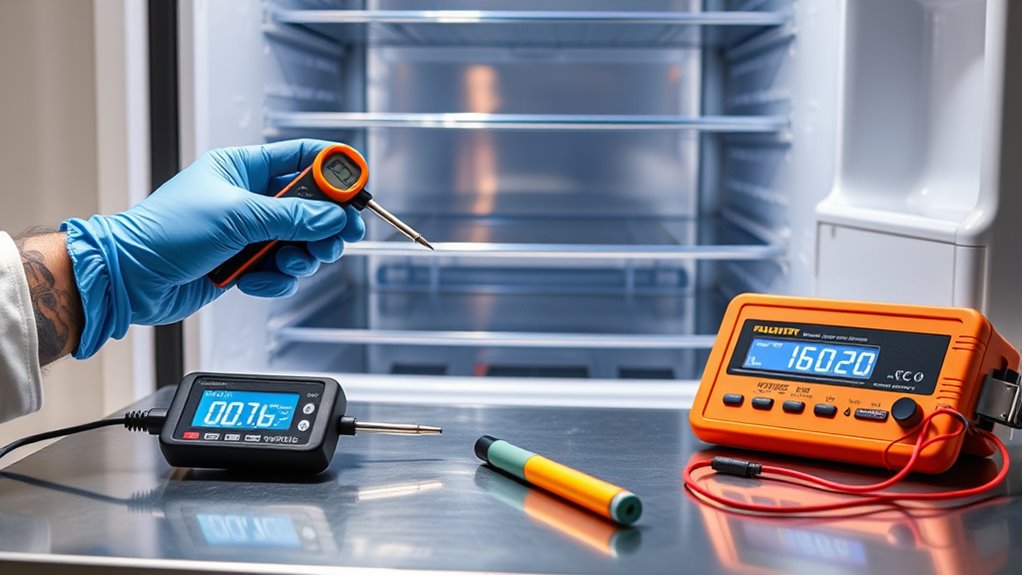
Troubleshooting refrigerator thermostats and thermistors requires careful attention to common signs of malfunction and systematic testing. Look for issues like improper cooling, extreme cold, temperature swings, delayed responses, or no cooling at all. Use a multimeter to check thermostat continuity—expect continuity when cold and none when warm. Inspect wiring for damage or disconnections, as faulty wiring can mimic thermostat failure. Ensure vents and airflow inside the fridge are clear to prevent uneven temperature distribution. Always unplug the unit before testing or repairing to avoid shocks, and use insulated tools for safety. Handle sensors gently to prevent damage. Regular calibration and understanding of the optimal angles for pinball machines can also help in maintaining equipment. After adjustments, verify the temperature with an accurate thermometer and allow the fridge to stabilize. If unsure, call a professional for help.
Frequently Asked Questions
How Often Should I Recalibrate My Refrigerator Thermostat?
You should recalibrate your refrigerator thermostat once or twice a year, typically every 6 to 12 months. Check it more often after moving the fridge, power outages, or seasonal temperature changes. If you notice your fridge isn’t cooling properly or food isn’t staying fresh, it’s time for recalibration. Use a dedicated thermometer for accuracy, and consider professional help if calibration issues persist.
Can Temperature Fluctuations Affect Food Safety and Preservation?
Temperature fluctuations can seriously impact food safety and preservation. When your fridge temperature varies, bacteria like Listeria and Salmonella can grow faster, increasing health risks. These changes also speed up spoilage, reducing shelf life and compromising food quality. By keeping your refrigerator consistently below 41 °F, you minimize microbial growth and extend freshness. Regularly monitoring and calibrating your thermostat helps maintain stable temperatures, protecting both your food and your health.
Is It Necessary to Recalibrate if the Fridge Feels Warm?
If your fridge feels warm, recalibration is often necessary. First, verify the temperature with a separate, accurate thermometer. If the reading is off, adjust the thermostat or sensor accordingly. In many cases, recalibrating thermistors—especially if they provide incorrect feedback—is essential to restore proper cooling. Regular maintenance and calibration guarantee your fridge maintains the right temperature, preventing spoilage and keeping your food safe.
What Are Signs of a Faulty Thermostat Requiring Calibration?
If your fridge’s temperature feels inconsistent or too warm despite setting adjustments, your thermostat might be faulty. You’ll notice the interior temperature doesn’t match the display, or the compressor runs constantly or too infrequently. Food spoils faster or freezes unexpectedly. Also, if the thermostat dial or control isn’t responding, it’s a sign you need calibration or replacement. Conducting a multimeter test can confirm if the thermostat’s signals are accurate.
Are There Professional Services for Thermostat Calibration?
Yes, professional services can calibrate your thermostat. For example, a food storage facility recently hired a certified calibration provider to guarantee their refrigerators maintained precise temperatures. They used onsite calibration with advanced equipment, meeting strict industry standards. You can access similar services that offer quick turnaround times, traceability to national standards like NIST, and ongoing support, ensuring your refrigeration systems stay accurate and reliable, protecting your products and compliance.
Conclusion
Now you’re all set to keep your fridge perfectly temped—who knew calibration could be so straightforward? Ironically, after all this fuss, your fridge might still decide to rebel just when you think it’s set. But hey, at least you’ll know you’ve done your part, and next time it acts up, you’ll have the tools to tame it. Because in the world of refrigerator calibration, a little effort goes a long way—and maybe a little patience, too.
